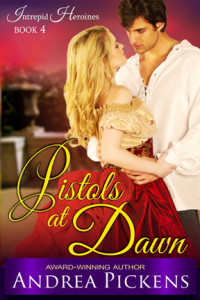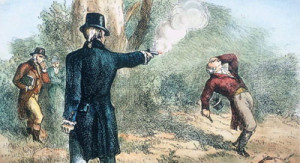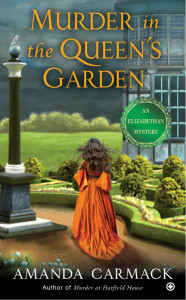
 It’s Tuesday, and Amanda has a deadline coming up in–gasp!–two weeks! In desperation, she turned to her friend Andrea Pickens aka Cara Elliott (who has some very exciting re-issues out) to fill in….
It’s Tuesday, and Amanda has a deadline coming up in–gasp!–two weeks! In desperation, she turned to her friend Andrea Pickens aka Cara Elliott (who has some very exciting re-issues out) to fill in….
Hi Everyone,
Andrea Pickens here, (that is, Cara Elliott slipping back into her OTHER Regency gown. It’s been hanging in the armoire for a while, but my lady’s maid has freshened up the lace and flounces, so I am ready to take a new twirl on the ballroom floor.) Amanda’s dueling with a looming deadline, so I volunteered to take a shot at today’s post . ..
 I confess that my aim is not entirely altruistic. Pistols At Dawn, my new, never-before-published traditional Regency is making its debut as an e-book on all the major platforms on June 2, so of course, I’d love to trigger your interest. (Okay, okay, enough with the gun references, but a pistol does figure prominently in the opening scene.)
I confess that my aim is not entirely altruistic. Pistols At Dawn, my new, never-before-published traditional Regency is making its debut as an e-book on all the major platforms on June 2, so of course, I’d love to trigger your interest. (Okay, okay, enough with the gun references, but a pistol does figure prominently in the opening scene.)
A metallic click caused Marcus Fitzherbert Greeley, the seventh Earl of Killingworth to look up from his ledgers.
“Who’s there?” he called sharply.
No answer sounded in reply, but after a moment the draperies stirred and a dark shape emerged from the midnight shadows. As the cloaked figure approached his desk, candlelight glinted off the steel of an ancient pistol.
“Stand up,” came the curt command.
The case clock ticked off a second or two before the earl put down his pen and rose.
“Take off your coat.”
He didn’t move, save for a slight twitch of his raven brows.
“You think a mere female incapable of pulling the trigger? I assure you, I should like nothing better, if you give me the slightest provocation.” The young lady—for her speech, if not her actions, indicated that she was indeed a lady—stepped closer. “And in case you are wondering, I am accorded to be a decent shot.”
I started my writing career Signet, which, as most of you know, published a special line of traditional Regency romances. I did ten books for them, during which time I learned an amazing amount of stuff, both about the craft of writing and the intricate nuances of the era. (And also met some of my best friends to this day, including Amanda!)
Like many Signet authors, I got the rights back to those early books and the process of getting them re-edited and formatted for self-publishing, made me think a lot about the “trad” Regency form and what I loved about it. For one, it’s a shorter length, usually 60-70,000 words rather than the 85-95,000 of mass market historical, and with fewer words to play with, an author has to really concentrate on developing the character arc—what’s the core conflict that is keeping the hero and heroine apart, and how do they grow and change in order to resolve it? Plot is of course important, but at heart, it’s the main characters who must stay in clear focus.
But what I also loved about the “rules” of the trad was that you really had to know your facts about the Regency. Want to write about pistols? Well, you had better research the details, and get them right, as core readers expected a high level of expertise. Since I love arcane facts about history, that part of writing was always great fun. So, when I found an old, unfinished manuscript for a trad Regency in my desk drawer, I decided to go back to my roots and finish it.
Things have gotten looser these days in Regency historical. Many authors don’t feel compelled to be quite as “authentic” as in the trads. The stories are still wonderful, they are just . . . different. In sitting down to finish Pistols At Dawn, I really enjoyed the fact that I had to rein in certain urges, and work within tighter constraints. I found myself dusting off old research books to do some background reading. Take, for examples, pistols. Now, most of us have heard of Joseph Manton but did you known the most famous gunmaker of the late Georgian/early Regency era was Robert Wogdon? (He made the weapons used in the infamous Aaron Burr-Alexander Hamilton duel, and one of the innovations that he helped pioneer was the hair—or “set”—trigger.) Indeed, in England his name became so synonymous with dueling that dawn encounter was sometimes referred to as a “Wogdon affair.”
 Now pistols actually play a very small role in my new book, but no matter—the enjoyment of reading and researching about the subject was well worth the hours spent. (Another fun fact—smoothbore weapons were considered more sporting for dueling . . . but even Manton was said to have “cheated” a little by adding rifling deep within the barrel for greater accuracy, but leaving the last few inches smooth, so it looked like an unrifled pistol.)
Now pistols actually play a very small role in my new book, but no matter—the enjoyment of reading and researching about the subject was well worth the hours spent. (Another fun fact—smoothbore weapons were considered more sporting for dueling . . . but even Manton was said to have “cheated” a little by adding rifling deep within the barrel for greater accuracy, but leaving the last few inches smooth, so it looked like an unrifled pistol.)
I could, of course go on and on about all the other esoteric discoveries I’ve made concerning the world of the Regency, but I’d rather wrap up my visit here by firing a question at you—What’s one of the most fun or interesting facts you’ve learned while reading the Regency? It can be about fashion, music, art, people, everyday objects—anything! Please share. (I’ll be giving away an e-book edition of Pistols At Dawn to one person chosen at random from among those who leave a comment here between now and Thursday.)
First of all, I have to send a shout-out to Risky Carolyn for posting this very appropriate, and timely, graph of the writing process on Facebook. I am now firmly in the “write everything and cry” phase, since this WIP is due June 1 and is at that stage where the characters do want to listen to anything I say. I will see you when I creep out of the cave in a couple of weeks, looking to replenish my chocolate supply.
 What am I writing??? Glad you asked! I am working on book 3 of my
What am I writing??? Glad you asked! I am working on book 3 of my  Kate Haywood Elizabethan Mystery series, Murder in the Queen’s Garden, set in the summer of 1559 at Nonsuch Palace, while Queen Elizabeth is on progress to various palaces and private homes while the weather is warm. It’s set at Nonsuch Palace, and I’ve had so much fun researching this most unusual castle. (though I must admit–I know of no real-life horrid murders that took place that, so I made a couple up…)
Kate Haywood Elizabethan Mystery series, Murder in the Queen’s Garden, set in the summer of 1559 at Nonsuch Palace, while Queen Elizabeth is on progress to various palaces and private homes while the weather is warm. It’s set at Nonsuch Palace, and I’ve had so much fun researching this most unusual castle. (though I must admit–I know of no real-life horrid murders that took place that, so I made a couple up…)
Nonsuch, as the name implies, was different from any other royal palace in England, smaller, more luxurious, more elaborate, meant to rival the splendid royal chateaux in France (like Chambord). Henry VIII began the building in Surrey on on April 22, 1538, tearing down an entire village and old manor house in order to do so. It was mostly finished by 1541, but not completed for several years after that. In fact, it was still incomplete when Henry died in 1547. In 1556 Queen Mary, his daughter, sold it to the Earl of Arundel, one of the richest lords in England who completed it. (In my story, Arundel has some vain hopes of marrying Queen Elizabeth, and hopes to use the palace to impress and entice her…). It returned to royal hands in the 1590s, and remained royal property until 1670, when Charles II gave it to his mistress, Barbar Castlemaine. She had it pulled down around 1682–3 and sold off the building materials to pay gambling debts. Some elements were incorporated into other buildings, but no trace of the palace remains on its site today. Some pieces are held by the British Museum.
Only about three contemporary images of the palace survive, and they don’t reveal very much about either the layout or the details of the building. The site was excavated in 1959–60. The plan of the palace was quite simple with inner and outer courtyards, each with a fortified gatehouse. To the north, it was fortified in the medieval style, but the southern face had ornate Renaissance decoration, with tall octagonal towers at each end ornamented with classical statues of gods and goddesses and bas reliefs.
 The 1959 excavation of Nonsuch was a key event in the history of archaeology in the UK. It was one of the first post-medieval sites to be excavated, and attracted over 75,000 visitors during the work. A great research source I’ve used in this story is 2005’s Nonsuch Palace: The Material Culture of a Noble Restoration Household by Martin Biddle. There’s also a great website about the excavation work and a recreated model here.
The 1959 excavation of Nonsuch was a key event in the history of archaeology in the UK. It was one of the first post-medieval sites to be excavated, and attracted over 75,000 visitors during the work. A great research source I’ve used in this story is 2005’s Nonsuch Palace: The Material Culture of a Noble Restoration Household by Martin Biddle. There’s also a great website about the excavation work and a recreated model here.
I’ve loved spending time at Nonsuch in my imagination while I work on this story!! (though i admit,at this point I just want it to be DONE). I hope you’ll enjoy reading it. Murder in the Queen’s Garden will be out in February 2015….
What vanished palaces from the past would YOU want to visit with your time machine???
So I wrote this post but there were too many swear words so I posted it over at my blog. You can read it here. But it explains why you get tulips today.
The winner of the Sandy Schwab book giveaway is:
bn100
Sandy will be contacting you!.